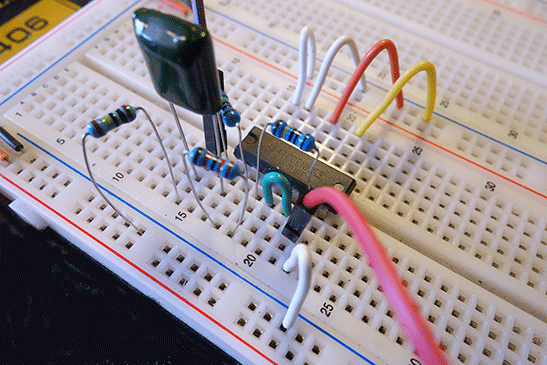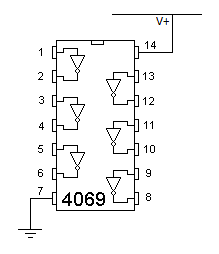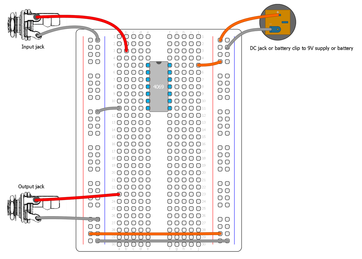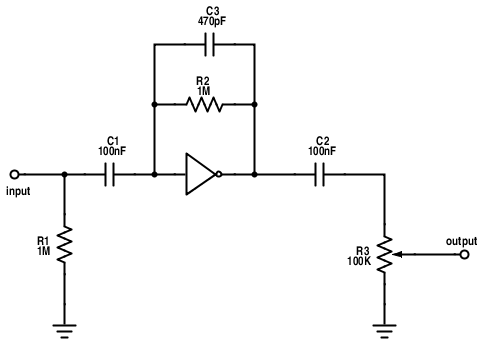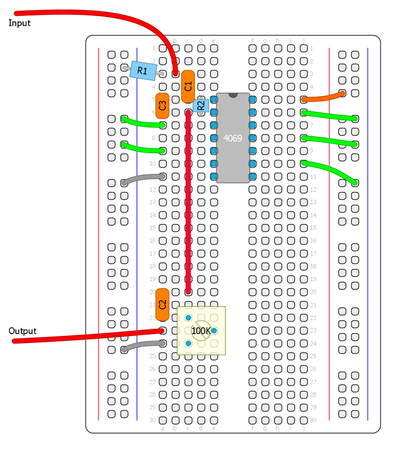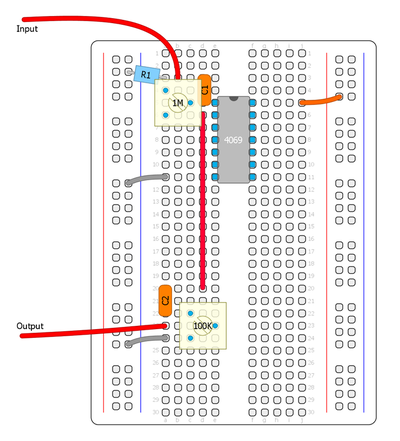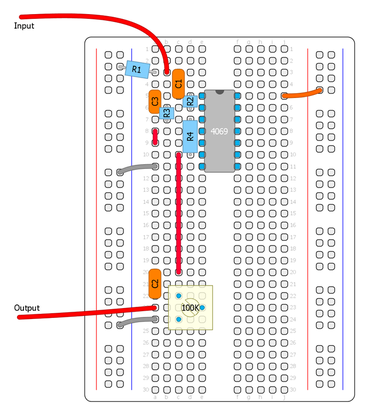4. Pulldown/up resistors These resistors are often needed in CMOS circuits. They are useful when we want to force a high or low output state when the input is not changing, but still leave the input able to accept a input signal. They are typically a high value from 10K - 100K and goes to ground (pulldown) or V+ (pullup) at the input of the gate. For example, if we have a gated oscillator on the input and we want to make sure the output always goes to ground when the oscillator is off we need a pullup resistor at the input (assuming the gate is inverting). We will use a few pratical examples later on. 5. Lets breadboard the "CMOS'ifier", a simple square wave fuzz. We will use this circuit as the front end for the guitar signal, so we can do other things later on, such as octave down. But it also makes a pretty cool fuzz on it's own. For this we will use a CD4069 chip, simply because it has a easier pinout than the CD4049 and takes less space on the breadboard. First, lets take a look at the pinout of this chip. Lets connect input/output jacks, power and ground to the breadboard and the chip like this (these connections will not be shown later): Stage 1. Preamp Our first stage of our circuit will be boosting the guitar signal into logic levels. This is a gainstage similar to many CMOS based distortions, such as the classic Tube Sound Fuzz by Craig Anderton. This is one of the exceptions to the digital logic and can only be done with the CD4069/CD4049. It gives a very pleasing distortion, but has the drawback of being rather noisy.
Lets put it up on the breadboard. Notice the green wires in the first image that are used to disable all the unused inputs. This will not be shown later, but it's a good pratice to always disable any unused input. The second image shows the same circuit with a trimmer for gain control. Put several gainstages in series for a sweet sounding distortion. I usually have two gainstages in my designs when I have one extra inverter left over. We can use any circuit to boost the signal into logic levels, transistor-based or op amp, but the advantage with this method is that we're only used 1/6 of one chip. So the rest of the inverters can still be used for other things, oscillators, LFO, filters ect. and this will save us some space. Another easy way is to use a LM386 amplifier chip and boost the signals into a squarewave (common in many Tim Escobedo designs), or a op amp comparator.
Next part: CMOS workshop part 3
29 Comments
thehallofshields
8/22/2015 07:11:54 am
I'm trying this with a 4049 and second stage is incredibly gated. It takes an additional gain of 10 from a pedal to get a steady signal through.
Reply
8/22/2015 06:34:12 pm
Hi,
Reply
thehallofshields
8/26/2015 06:30:48 am
I'm still having issues using the 4049 as a Schmitt Trigger.
Reply
8/27/2015 08:50:00 am
I just realized a type in my post. R4 should be the fixed 1M value and you should play around with R3. Sorry about that! There isn't even a R5 which I mention in the same sentence.. :P Anyway, try R3: 10-47 K and R4: 1M. It should work alot better!
Reply
thehallofshields
9/18/2015 03:21:09 pm
I switched over from a 4049 to a 4069 then realized:
Marek
8/24/2015 01:46:35 am
Is there a CMOS like the CD4049UBE that isn't that noisy?
Reply
8/24/2015 06:36:10 am
Hi Marek,
Reply
Marek
8/24/2015 07:00:45 pm
Would it be less noisy if i would make the inverters "by hand" using a n-channel transistor and a p-channel transistor? could i get there somehow?
thehallofshields
8/25/2015 05:23:46 am
Take a look at PureTube's 'SansValve'.
Marek
8/25/2015 06:23:04 pm
Thanks man, this is pretty much what i looked for ^^ 8/27/2015 08:57:09 am
That's cool! I think I'll draw up a vero layout for the sansvalve, or experiment with a couple of them in series with a CD4007. :)
thehallofshields
9/18/2015 03:31:47 pm
I don't find the 4049 to be that noisy when you turn down the gain by lowering the Feedback Resistors. 8/25/2015 03:50:13 am
I'm afraid that I don't know how that would be possible, but it's an interesting idea
Reply
Synsound
8/24/2015 02:26:18 pm
I'm excited to follow these lessons. I want to wait to read part one so I don't get ahead of myself. From the little I have read it seems well written for someone with little technical background, like me, to follow and comprehend. Thanks for the circuits and now the knowledge. Keep up the good work!
Reply
Charles
8/25/2015 02:58:20 pm
Yeah man this rules, thanks Fredrik.
thehallofshields
9/7/2015 02:29:19 pm
Could you explain the Schmitt Trigger arrangement?
Reply
9/15/2015 02:25:43 pm
Sorry, I missed your comment. There is another principle at work here, not just maximum gain. The resistors sets the threshold for triggering action depending on the input voltage. The linear amplifier configuration is not at work at all here. Sorry, I wish I could explain it better but that would require a looong reply. :)
Reply
thehallofshields
9/18/2015 03:26:42 pm
Got it. I wish I could better understand how the Supply Voltage, Input Resistor and Feedback Resistor all contribute to the Gain, Gating Threshold and Output Impedance.
Marek
10/19/2015 04:03:58 am
Hi, me again.
Reply
thehallofshields
3/19/2016 12:38:26 pm
The Schmitt Trigger will only switch after the Zero-Crossing + 1/3 of the Supply-Voltage right? Does this eliminate the need for low-pass filtering?
Reply
3/23/2016 04:43:29 am
Yes, you are right. But it doesn't eliminate the need for low-pass filtering.
Reply
pango
7/12/2017 10:00:53 am
Hi Fredrik, thanks for posting this!
Reply
Jakob
8/6/2017 02:43:37 am
Does your CD4069 get really hot? or is it just me?
Reply
Andy
11/16/2018 01:44:34 am
Is the resistor labelling here wrong? :
Reply
11/16/2018 09:30:44 am
Hi Andy,
Reply
Andy
11/19/2018 02:44:36 am
Thanks. I like the idea that the Schmitt trigger can be made adjustable.
Feri
11/3/2019 05:39:27 am
Hey Friedrik!
Reply
Leave a Reply. |
